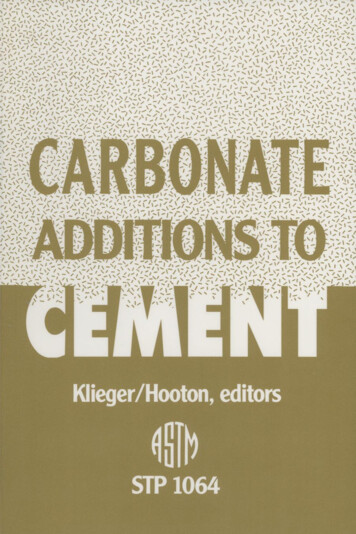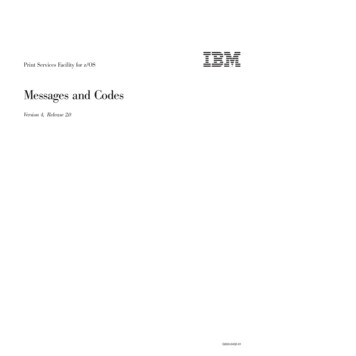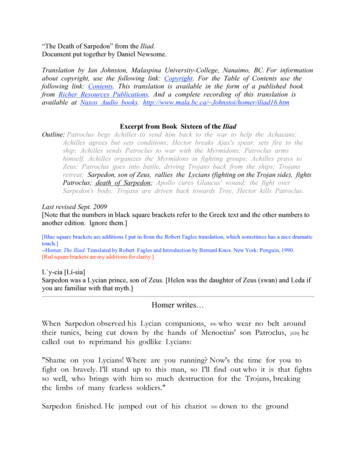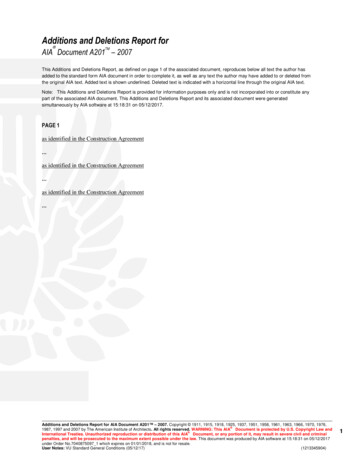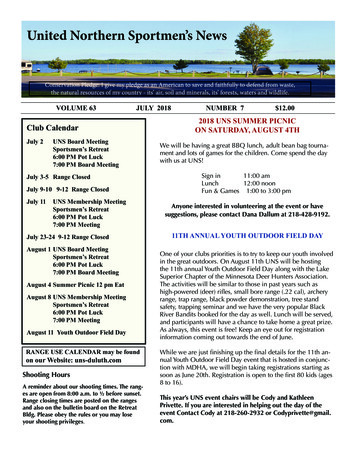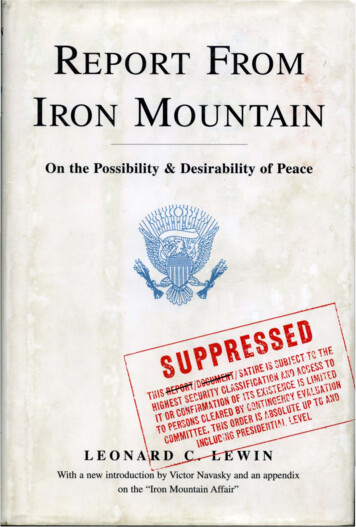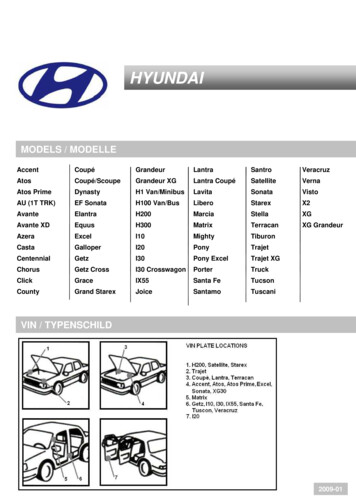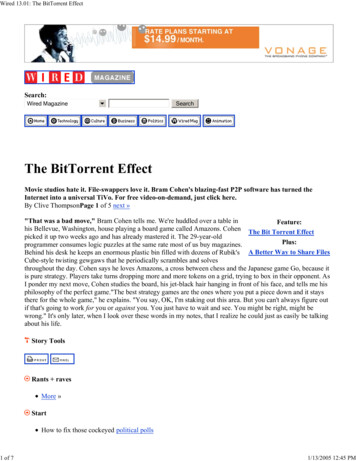
Transcription
Sains Malaysiana 49(12)(2020): 36Effect of Bismuth Additions on Wettability, Intermetallic Compound, andMicrohardness Properties of Sn-0.7Cu on Different Surface Finish Substrates(Kesan Penambahan Bismut kepada Kebasahan, Sebatian antara Logam dan Sifat Mikrokekerasan Sn-0.7Cu terhadapSubstrat Akhir Berlainan Kemasan)M OHD I ZRUL I ZWAN R AMLI, M OHD A RIF A NUAR M OHD S ALLEH*, S ITI F ARAHNABILAH M UHD A MLI & N URULR AZLIANA A BDUL R AZAKABSTRACTThe influence of bismuth (Bi) addition on wettability, thickness of interfacial intermetallic compound (IMC), andmicrohardness properties of Sn-0.7Cu xBi solder alloy using different types of substrate were examined. The 0.5,1.0, 1.5, and 2.0 wt. % Bi was added into Sn-0.7Cu and fabricated using the casting process. The result shows that theinfluence of 1.5 wt. % Bi in the Sn-0.7Cu solder soldered on copper organic solderability preservative (Cu-OSP) andimmersion tin (Im-Sn) surface finish has improved the wettability and microhardness. Subsequently, the IMC thicknessof Sn-0.7Cu 1.5Bi solder alloy on Im-Sn surface finish gives a better result than reflowed on Cu-OSP. Generally,with the addition of 1.5 wt. % Bi in Sn-0.7Cu solder alloy reflowed on the Im-Sn surface finish had enhanced theperformance in terms of wettability, thickness of IMC and microhardness properties compared to on Cu-OSP surfacefinish.Keywords: Bismuth; solder alloy; surface finish; wettabilityABSTRAKDalam kajian ini, kesan penambahan bismut (Bi) terhadap kebasahan, ketebalan antaramuka sebatian antara logam(IMC) dan sifat mikrokekerasan pateri bebas plumbum Sn-0.7Cu xBi menggunakan pelbagai jenis substrat telahdikaji. Penambahan 0.5, 1.0, 1.5 dan 2.0 bt. % Bismut ke dalam Sn-0,7Cu dibuat menggunakan kaedah peleburan.Hasil kajian menunjukkan bahawa penambahan 1.5 bt. % Bi pateri Sn-0.7Cu yang dipaterikan pada permukaanCu-OSP dan rendaman timah (ImSn) meningkatkan kebasahan dan mikrokekerasan. Selain itu, ketebalan IMC untukpateri Sn-0.7Cu 1.5Bi pada kemasan permukaan Im-Sn memberikan hasil yang lebih baik berbanding aliran semulapada permukaan pada Cu-OSP. Secara keseluruhan, dapat disimpulkan bahawa 1.5 bt. % Bi dalam pateri Sn-0.7Cuyang telah dialirkan semula pada permukaan ImSn telah meningkatkan ciri-ciri kebasahan, ketebalan IMC dan sifatmikrokekerasan berbanding pada permukaan Cu-OSP.Kata kunci: Aloi pateri; bismut; kebasahan; kemasan permukaanI NTRODUCTIONOver the past few years, the tin lead (Sn-Pb) solderhas been used in electronics application because it hasgood soldering, reliability and pricing (Cheng et al.2017). Nevertheless, it was found that lead is toxicityand harmful to humans. Due to that, many researchersextensively developed to find the suitable Pb-free soldercandidates. The two most preferred substitutes to thecommon Sn-Pb solder were tin silver copper (Sn-Ag-Cu)and tin copper (Sn-0.7Cu) (Hu et al. 2015). The Sn-0.7Cusolder is one of anticipated replacements solder as it is lowcost solder with great solder joint performance.However, the wettability and mechanical propertiesof Sn-07Cu solder are recognized as a poor solder due tothe brittle behaviour of intermetallic compound (IMC) inthe solder (Izwan Ramli et al. 2020a). Hence, the alloyingmethod has been considered as additives such as bismuth(Bi) (Belyakov et al. 2017), nickel (Ni) (Ventura et al.2011), and zinc (Zn) (Ng et al. 2015) elements to expandthe properties of the Sn-0.7Cu solder. Besides alloyingelement, the printed circuit board (PCB) assembly processwith a surface finish become a focus in electronic industry.In addition, there are limited studies regarding the differentsurface finish including Cu-OSP and immersion tin. Thus,
3256this paper focused on the influence of Bi addition on Sn0.7Cu solder on Cu-OSP and ImSn surface finish.M ATERIALS AND M ETHODSThe base material which is Sn-0.7Cu was mixed withbismuth (Bi) granules with different compositions (0.5,1.0, 1.5 and 2.0 wt. %) via casting technique. Firstly, theSn-0.7Cu alloy were heated up at 250 C in a castingfurnace. After the Sn-0.7Cu solder become melted, thedifferent composition of Bi granules was added. The newsolder alloy was stirred frequently for homogenisationand poured into a stainless-steel mould. The Sn-0.7Cusolder with Bismuth addition was removed and the solderball was fabrication for microstructure and interfacial IMCanalysis. Meanwhile, for wettability, the Sn-0.7Cu xBisolder were weighted at 0.5 g before reflowing onsubstrate. All samples were then reflowed using a F4Nreflow oven with small addition of flux and two types ofsurface finish underlying on the copper substrate whichis Copper-Organic Solderability Preservative (Cu-OSP)and Immersion Tin (ImSn) PCB FR4 type. Subsequently, toobserve the cross-section area, the samples were cleanedand perform grinded and polished.Wettability of solder was determined with respectto the contact angle of Sn-0.7Cu xBi solder form oncopper substrate as showed in Figure 1. A cross-sectionalsample were prepared for each composition and surfacefinish. The Optical Microscope (ECLIPSE L300N) andImage-J software was used to examine the sample. Theaverage of thickness IMC also measured by using theImage-J software as define in Figure 2. Subsequently, forthe microhardness testing, samples were measured by usingthe FV-700e Vickers microhardness following ASTMstandard E-384. Before conducting the experiments,the samples were metallographically ground andpolished into flat area in order to get proper indentionand accurate reading. The measurement was made using1 kgf indention load and a dwell for 10 s with 5 differentindentation points for each sample.FIGURE 1. Measurement of contact angle of solder on Cu-OSPand Im-Sn substrateFIGURE 2. Illustration of the area and length of the measured IMC layer thickness
3257R ESULTS AND D ISCUSSIONWETTABILITY BEHAVIOURThe wettability of solder alloy was determined based on thecontact angle (θ) to the Cu-OSP and Im-Sn surface finish(Mohd Salleh et al. 2011). According to Mhd Noor et al.(2016a), smaller contact angle give the better wettabilityof the solder. As reported by Rita et al. (2015), theyclaimed that the range between 20 θ 40 was theacceptable range for contact angle. Moreover, the contactangle considered inaccurate when the value is more than40 . Figure 3 shows the variation of wetting angle of Sn0.7Cu xBi solder on Cu-OSP and Im-Sn surface finish.For Cu-OSP surface finish, the contact angle decreasedfrom 31.44 to 26.94 with addition of 1.0 wt. % of Bi.However, with the addition of 2.0 wt. % of Bi, the contactangle of Sn-0.7Cu solder alloy increased to 30.9 due tohigher surface tension.Meanwhile, for Im-Sn surface finish, the contactangle continued to decrease from 23.88 to 14.38 when1.5 wt. % of Bi was added. Then, the trend was slightlyincreased from 14.38 to 17.63 when Bi addition up to2.0 wt. % of Bi. The observation shows that the Cu-OSPhas largest contact angle than the Im-Sn surface finish.Comparable result was found in studies by Muhd Amliet al. (2019) which investigated the wettability of theSn-3.0Ag-0.5Cu solder on four different surface finishincluding the Cu-OSP and Im-Sn. The result shows that theCu-OSP has the largest contact angle compared to Im-Sn,ENIG, and ImAg. Moreover, Muhd Amli et al. (2019) alsofound that the Im-Sn has better contact angle due to thelower surface tension compare to Cu-OSP surface finish.The adding of 1 wt. % Bi element reduces the contactangle, hence improves the wettability properties (Saidet al. 2015). The contact angle of Sn-0.7Cu solder hadimproved with suitable amount of addition Bi.FIGURE 3. Average of contact angle of Sn-0.7Cu xBi solderedon Cu-OSP and Im-Sn substrateTHICKNESS OF INTERMETALLIC COMPOUNDIn the electronic packaging, the thickness of theintermetallic compounds (IMCs) is crucial since it isrelated to the reliability of the solder joint (Said etal. 2015). The thickness of IMC measurements of Sn0.7Cu xBi on Cu- OSP and Im-Sn surface finish isshown in Figure 4. The acceptable range for thicknessintermetallic compound was not more than 25.0 μm foras-reflowed sample. The results show that the thicknessof IMC using Sn-0.7Cu solder on Cu- OSP substratedecreases from 21.29 to 19.48 μm with addition 0.5 wt.% Bi. However, the thickness of IMC increase withincreases of Bi addition on Sn-0.7Cu. For Im-Sn substrate,the thickness of IMC increased when 0.5 wt. % Bi wasadded into Sn-0.7Cu then slightly decreased to 11.76μm for Sn-0.7Cu 1.5Bi. Comparing the IMC thicknesson Cu-OSP and Im-Sn, it shows that the IMC thickness onIm-Sn is lower than Cu-OSP. This is because, when Sn0.7Cu xBi solder reflowed on Im-Sn, a thin layered of ImSn which coated the Copper substrate will act as barrier
3258to prevent the excessive Copper diffusion from substratetowards solder. Study by Musa et al. (2015) reportedon the influence of 1 wt. % Bi in Sn-2.8Cu-0.5Cu solderwere able to inhibit the growth of IMC during thermalaging process. Mhd Noor et al. (2016b) also reported thethickness of IMC decreased after 10 wt. % Bi addition tothe Sn solder alloy. In conclusion, the influence of smallamount of Bi into Sn-0.7Cu solder alloy the excessiveformation of interfacial IMC was able to be suppressed.FIGURE 4. Intermetallics compound (IMC) thickness of Sn0.7Cu xBi soldered on Cu-OSP and Im-Sn substrateMICROHARDNES PROPERTIESIn Figure 5, the average of microhardness value ofSn-0.7Cu xBi solder soldered on Cu-OSP and Im-Snsurface finish. The optimal value of microhardness forSn-0.7Cu xBi solder soldered on Cu-OSP and Im-Snsubstrates was 14.92 and 15.22 HV, respectively, with 1.5wt. % of Bi element. However, with additions of 2.0 wt.% Bi, the value slightly decreases to 10.26 HV for Cu-OSPand 13.72 HV for Im-Sn surface finish. The decrement ofmicrohardness is related to the solubility limit of Bi inSn. Based on previous study reported by Izwan Ramli etal. (2020b) the solubility limit of Bi in Sn is 1.8 wt. %.Subsequently, when excessive addition of Bi elementin Sn, it will reduce the strength properties of solderdue to the brittleness behaviour of Bi element. It can beconcluded that, the addition of 1.5 wt. % Bi element intothe Sn-0.7Cu solder could improve the microhardnessdue to the solid solution strengthening effect in the β-Snarea. Similar results also reported by Liu and Sun (2013),that the addition Bi can enhanced the strength of SACsolder (Yang et al. 2013). Therefore, addition of 1.5 wt.% Bi on the Sn-0.7Cu solder alloy could enhance themicrohardness performance of the solder alloy.FIGURE 5. The average microhardness value of as-soldered Sn0.7Cu xBi on Cu-OSP and Im-Sn surface finish
3259C ONCLUSIONThe influence of different Bi addition in Sn-0.7Cu solderafter soldered on Cu-OSP and Im-Sn surface finish havebeen investigated in this work. Several conclusions thatcan be summarised as follows. The wettability of Sn0.7Cu 1.5Bi solder alloy on Im-Sn surface finish with14.38 contact angle gives lower contact angle comparedto on Cu-OSP surface finish with 26.94 contact angle, theaddition of 0.5 wt. % of Bi in Sn-0.7Cu solder on Cu-OSPand 1.5 wt. % Bi on Im-Sn surface finish suppressed theformation of IMC layer, and the average microhardnessof the Sn-0.7Cu solder increased by addition of 1.5 wt.% Bi.ACKNOWLEDGEMENTSThe authors would like to acknowledge the financialsupport throughout the research project from afundamental research grant scheme (FRGS) FRGS/1/2017/TK05/UniMAP/03/3 (9003-00621) from the Ministryof Higher Education, Malaysia. This project is alsosupported in part by the Universiti Malaysia Perlis(UniMAP) and the collaboration research project withNihon Superior Co. Ltd.REFERENCESBelyakov, S.A., Xian, J.W., Sweatman, K., Nishimura, T.,Akaiwa, T. & Gourlay, C.M. 2017. Influence of bismuthon the solidification of Sn-0.7 Cu-0.05 Ni-xBi/Cu joints.Journal of Alloys and Compounds 701: 321-334.Cheng, S., Huang, C.M. & Pecht, M. 2017. A review of leadfree solders for electronics applications. MicroelectronicsReliability 75: 77-95.Hu, X., Li, Y., Liu, Y. & Min, Z. 2015. Developments of highstrength Bi-Containing Sn0. 7Cu lead-free solder alloysprepared by directional solidification. Journal of Alloysand Compounds 625: 241-250.Izwan Ramli, M.I., Mohd Salleh, M.A.A., Abdullah, M.M.A.,Narayanan, P., Chaiprapa, J., Said, R.M., Yoriya, S. &Nogita, K. 2020a. The effect of Ni and Bi additions onthe solderability of Sn-0.7 Cu solder coatings. Journal ofElectronic Materials 49(1): 1-12.Izwan Ramli, M.I., Mohd Salleh, M.A.A., Yasuda, H.,Chaiprapa, J. & Nogita, K. 2020b. The effect of Bi onthe microstructure, electrical, wettability and mechanicalproperties of Sn-0.7Cu-0.05Ni alloys for high strengthsoldering. Materials & Design 186: 108281.Liu, Y. & Sun, F.L. 2013. Characterization of interfacial IMCsin low-Ag Sn–Ag–xCu–Bi–Ni solder joints. Journal ofMaterials Science: Materials in Electronics 24: 290-294.Mhd Noor, E.E., Mhd Nasir, N.F. & Idris, S.R.A. 2016a. Areview: Lead free solder and its wettability properties.Soldering & Surface Mount Technology 28(3): 125-132.Mhd Noor, E.E., Zuhailawati, H. & Radzali, O. 2016b. Lowtemperature In–Bi–Zn solder alloy on copper substrate.Journal of Materials Science: Materials in Electronics27(2): 1408-1415.Mohd Salleh, M.A.A., Hazizi, M.H., Ahmad, Z.A., Hussin, K.& Ahmad, K.R. 2011. Wettability, electrical and mechanicalproperties of 99.3 Sn-0.7 Cu/Si3N4 novel lead-freenanocomposite solder. Advanced Materials Research 277:106-111.Muhd Amli, S.F., Mohd Salleh, M.A.A., Said, R.M., AbdulRazak, N.R., Wahab, J.A. & Izwan Ramli, M.I. 2019. Effectof surface finish on the wettability and electrical resistivityof Sn-3.0 Ag-0.5 Cu solder. In IOP Conference Series:Materials Science And Engineering. Iop Publishing. 701(1):012029.Musa, S.A., Saud, N., Abdul Razak, N.R. & Hussin, K. 2015.Mechanical properties and solderability of robust Sn-0.7Cu lead-free composite solder. Applied Mechanics andMaterials 754: 556-560.Ng, W., Zeng, G., Nishimura, T., Sweatman, K., Mcdonald, S.D.& Nogita, K. 2015. The beneficial effect of Zn additions onthe microstructure of SnCu and SnCuNi solder jointsto Cu substrates. In 2015 International Conference onElectronics Packaging and iMAPS All Asia Conference(ICEP-IAAC). IEEE. pp. 809-813.Said, R.M., Saud, N., Mohd Salleh, M.A.A., Derman, M.N.,Izwan Ramli, M.I. & Mohd Nasir, N. 2015. Effect of SiCparticles addition on the wettability and intermetalliccompound layer formation of Sn-Cu-Ni (Sn100C) solderpaste. Applied Mechanics and Materials 754-755: 546-550.Ventura, T., Cho, Y.H., Kong, C. & Dahle, A.K. 2011. Formationof intermetallics in Sn-0.9 Cu and Sn-0.7 Cu-0.08 Nisolders. Journal of Electronic Materials 40(6): 1403-1408.Yang, L., Fenglian, S. & Miaosen, Y. 2013. Shear strengthand brittle failure of low-Ag SAC-Bi-Ni solder jointsduring ball shear test. In 14th International Conference OnElectronic Packaging Technology. IEEE. pp. 750-753.Mohd Izrul Izwan Ramli, Mohd Arif Anuar Mohd Salleh* &Siti Farahnabilah Muhd AmliCenter of Excellence Geopolymer & Green Technology(CeGeoTech)School of Materials EngineeringUniversiti Malaysia Perlis (UniMAP)Taman Muhibbah, 02600 Jejawi, PerlisMalaysiaNurul Razliana Abdul RazakDepartment of Mechanical TechnologyFaculty of EngineeringKampus UniCITI Alam Sungai ChuchuhPadang Besar, 02100 PerlisMalaysia*Corresponding author; email: arifanuar@unimap.edu.myReceived: 14 August 2020Accepted: 11 September 2020
intermetallic compound was not more than 25.0 μm for as-reflowed sample. The results show that the thickness of IMC using Sn-0.7Cu solder on Cu-OSP substrate decreases from 21.29 to 19.48 μm with addition 0.5 wt. % Bi. However, the thickness of IMC increase with increases of Bi addition on Sn-0.7Cu. For Im-Sn substrate,

